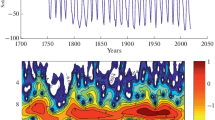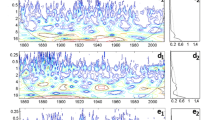Abstract
The present paper provides an analysis and a long-term forecasting scheme of the Oceanic Niño Index (ONI) using the continuous wavelet transform. First, it appears that oscillatory components with main periods of about 17, 31, 43, 61 and 140 months govern most of the variability of the signal, which is consistent with previous works. Then, this information enables us to derive a simple algorithm to model and forecast ONI. The model is based on the observation that the modes extracted from the signal are generally phased with positive or negative anomalies of ONI (El Niño and La Niña events). Such a feature is exploited to generate locally stationary curves that mimic this behavior and which can be easily extrapolated to form a basic forecast. The wavelet transform is then used again to smooth out the process and finalize the predictions. The skills of the technique described in this paper are assessed through retroactive forecasts of past El Niño and La Niña events and via classic indicators computed as functions of the lead time. The main asset of the proposed model resides in its long-lead prediction skills. Consequently, this approach should prove helpful as a complement to other models for estimating the long-term trends of ONI.






Similar content being viewed by others
Notes
It is actually phased with the 140-months component extracted from ONI restricted to 1950-1995 but this one corresponds to \(c_{140}\) around 1974 since border effects are negligible there.
References
Arneodo, A., Audit, B., Decoster, N., Muzy, J. -F., & Vaillant, C. (2002). The Science of Disasters: Climate Disruptions, Heart Attacks, and Market Crashes. Wavelet Based Multifractal Formalism: Applications to DNA Sequences, Satellite Images of the Cloud Structure, and Stock Market Data, pp. 27–102. Springer, Berlin.
Barnston, A. G., Tippett, M. K., L’Heureux, M. L., Li, S., & DeWitt, D. G. (2012). Skill of real-time seasonal ENSO model predictions during 2002–2011: Is our capability increasing? Bulletin of the American Meteorological Society, 93(5), 631–651.
Chen, D., Cane, M. A., Kaplan, A., Zebiak, S. E., & Huang, D. (2004). Predictability of El Niño over the past 148 years. Nature, 428(6984), 733–736.
CPC. Website. http://www.cpc.ncep.noaa.gov/products/analysis_monitoring/ensostuff/ensoyears2011.shtml. Accessed 18 Feb 2016.
Daubechies, I. (1992). Ten Lectures on Wavelets. SIAM, Philadelphia, PA.
Daubechies, I., Lu, J., & Wu, H.-T. (2011). Synchrosqueezed wavelet transforms: An empirical mode decomposition-like tool. Journal of Applied and Computational Harmonic Analysis, 30(2), 243–261.
Deliège, A., & Nicolay, S. (2016). Köppen–Geiger climate classification for Europe recaptured via the Hölder regularity of air temperature data. Pure and Applied Geophysics, 173(8), 2885–2898.
Deliège, A., & Nicolay, S. (2016b) A New Wavelet-Based Mode Decomposition for Oscillating Signals and Comparison with the Empirical Mode Decomposition. Information Technology: New Generations. In 13th International Conference on Information Technology, pp. 959–968. Springer, Cham.
Fedorov, A. V., Harper, S. L., Philander, S. G., Winter, B., & Wittenberg, A. (2003). How predictable is El Niño? Bulletin of the American Meteorological Society, 84(7), 911–919.
Glantz, M. H. (2001). Currents of Change: Impacts of El Niño and La Niña on climate society. Cambridge University Press, Cambridge.
Hsiang, S. M., Meng, K. C., & Cane, M. A. (2011). Civil conflicts are associated with the global climate. Nature, 476(7361), 438–441.
Jin, F.-F., Neelin, J. D., & Ghil, M. (1994). El Niño on the devil’s staircase: Annual subharmonic steps to chaos. Science, 264(5155), 70–72.
Mallat, S. (1999). A wavelet tour of signal processing. Academic Press, New York.
Mason, S. J., & Mimmack, G. M. (2002). Comparison of some statistical methods of probabilistic forecasting of ENSO. Journal of Climate, 15(1), 8–29.
Meyer, Y. (1993). Wavelets and Operators, volume 1. Cambridge University Press, Cambridge, p. 004
Nicolay, S. (2011). A wavelet-based mode decomposition. European Physical Journal B, 80, 223–232.
Nicolay, S., Mabille, G., Fettweis, X., & Erpicum, M. (2009). 30 and 43 Months period cycles found in air temperature time series using the Morlet wavelet method. Climate Dynamics, 33(7), 1117–1129.
Okumura, Y. M. (2013). Origins of tropical pacific decadal variability: Role of stochastic atmospheric forcing from the south pacific. Journal of Climate, 26(24), 9791–9796.
Petrova, D., Koopman, S. J., Ballester, J., & Rodó, X. (2016). Improving the long-lead predictability of El Niño using a novel forecasting scheme based on a dynamic components model. Climate Dynamics, pp. 1–28.
Saracco, G., Guillemain, P., & Kronland-Martinet, R. (1990). Characterization of elastic shells by the use of the wavelet transform. IEEE Ultrasonics, 2, 881–885.
Thompson, C. J., & Battisti, D. S. (2001). A linear stochastic dynamical model of ENSO. Part ii: Analysis. Journal of Climate, 14(4), 445–466.
Tippett, M. K., & Barnston, A. G. (2008). Skill of multimodel ENSO probability forecasts. Monthly Weather Review, 136(10), 3933–3946.
Torrence, C., & Compo, G. (1998). A practical guide to wavelet analysis. Bulletin of the American Meteorological Society, 79, 61–78.
Zheng, F., Zhu, J., Zhang, R. H., & Zhou, G. (2006). Improved ENSO forecasts by assimilating sea surface temperature observations into an intermediate coupled model. Advances in Atmospheric Sciences, 23(4), 615–624.
Zhu, J., Zhou, G.-Q., Zhang, R.-H., & Sun, Z. (2012). Improving ENSO prediction in a hybrid coupled model with an embedded entrainment temperature parameterisation. International Journal of Climatology, 33, 343–355.
Acknowledgements
The authors acknowledge the Climate Prediction Center (CPC) for providing the ONI signal (CPC 2011). They also wish to thank Dr. Desislava Petrova for providing fruitful discussions and suggestions that improved the quality of the article, as well as the anonymous reviewers for their constructive comments that helped clarify the manuscript.
Author information
Authors and Affiliations
Corresponding author
Electronic supplementary material
Below is the link to the electronic supplementary material.
Appendices
Appendix A: Iterations of the CWT
When it comes to extracting components from a signal s as accurately as possible, the CWT can be used several times to sharpen the desired modes. More precisely, if the components of interest are located at scales \((a_i)_{i\in I}\) (for some set of indices I), then at the first iteration one can extract \((c_i^1)_{i\in I}\) as
Then repeat the process, i.e. the CWT and extraction at the same scales \((a_i)_{i\in I}\) but with
get the modes \((c_i^2)_{i\in I}\), repeat with \(s_2=s_1-\sum _{i\in I}c_i^2\), and so on. Stop the process when the components extracted are not significant anymore, i.e. at iteration J if
where \(\left\| .\right\|\) denotes the energy (square of \(L^2\) norm) of a signal and \(\alpha\) is a threshold typically chosen as 0.01. The final components \((c_i)_{i\in I}\) are then obtained as
Appendix B: Details for \(y_{43}^1\)
For simplification, let us write s instead of \(s_3\) and y instead of \(y_{43}^1\). If y is already known up to time \(t-1\), here are the steps describing how to obtain y(t). We note \(p(t-1)\) the position of the peak used to generate \(y(t-1)=A_{43}\cos (2\pi (t-1-p(t-1))/43)\). We use a variable called lock to prevent abrupt changes from \(p(t-1)\) to p(t). To obtain p(t), proceed as follows.

Then \(y(t)=A_{43}\cos (2\pi (t-p(t))/43)\). Special mention for \(y_{61}\) in order to better synchronize the forecasts with EN events: if it comes that \(y_{61}\) reaches a peak before \(s_1\), impose that \(y_{61}\) stays at \(A_{61}\).
Rights and permissions
About this article
Cite this article
Deliège, A., Nicolay, S. Analysis and Indications on Long-term Forecasting of the Oceanic Niño Index with Wavelet-Induced Components. Pure Appl. Geophys. 174, 1815–1826 (2017). https://doi.org/10.1007/s00024-017-1491-4
Received:
Revised:
Accepted:
Published:
Issue Date:
DOI: https://doi.org/10.1007/s00024-017-1491-4




